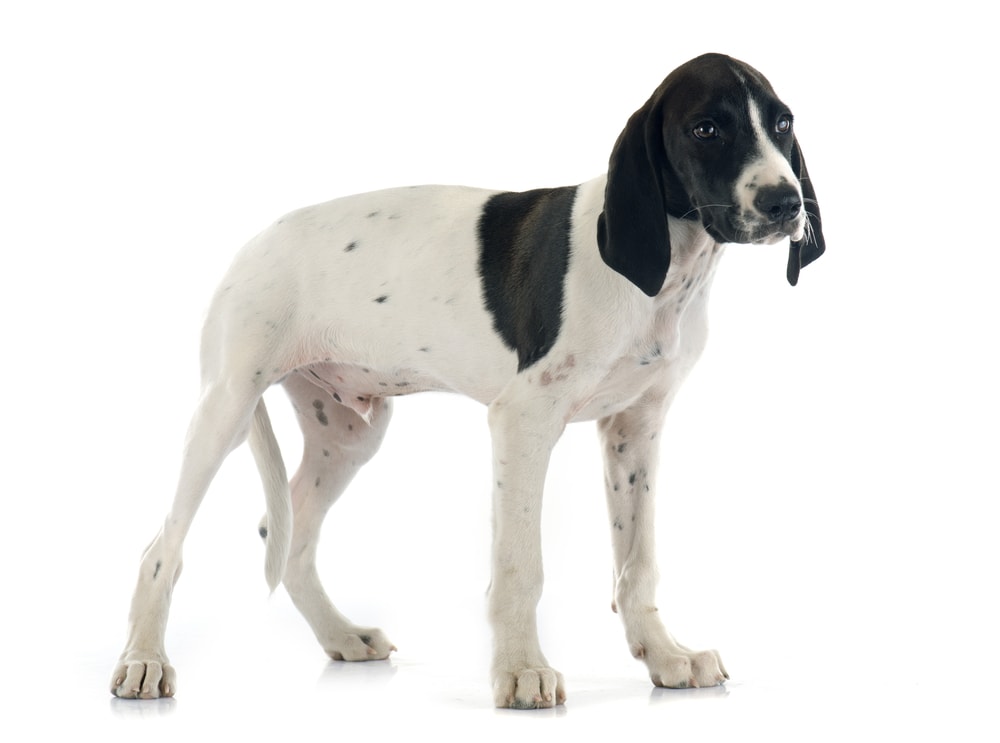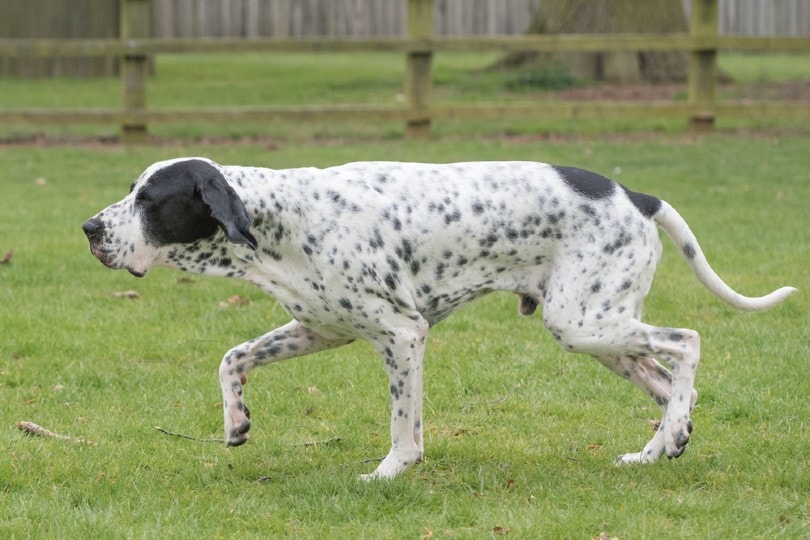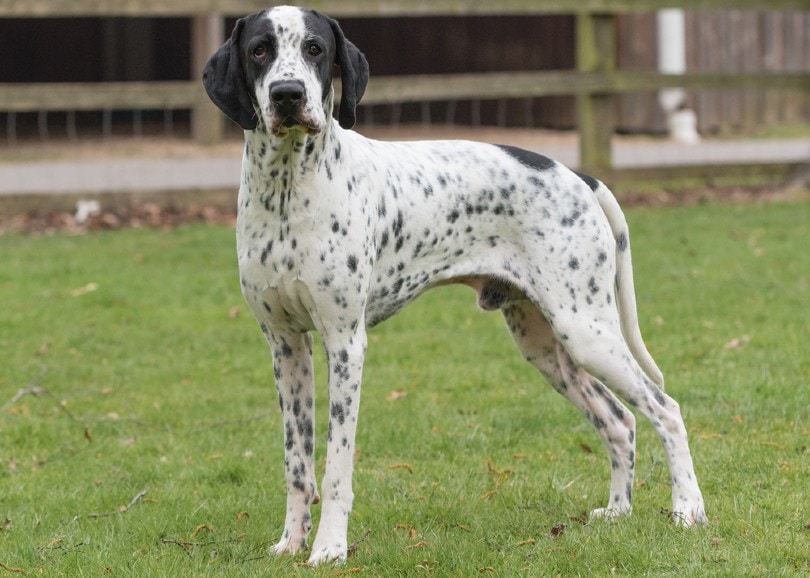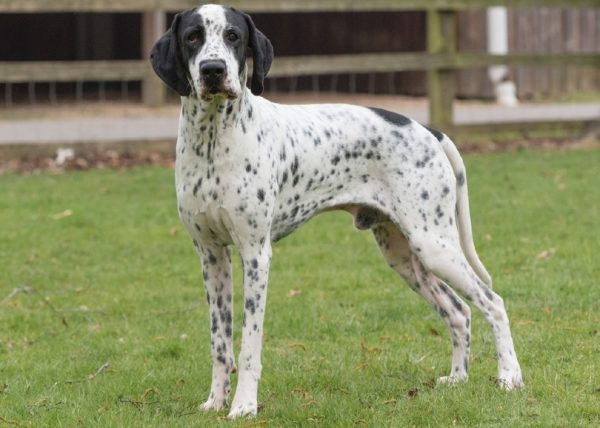Click Below to Skip Ahead
If you’re like most people, you’ve probably never heard of the Braque d’Auvergne. That’s a shame because these French gun dogs make wonderful companions, even if the only thing you ever hunt for is the remote control.
Breed Overview
Height:
20 – 26 inches
Weight:
40 – 65 pounds
Lifespan:
12 – 15 years
Colors:
Black and white in ticked or roan
Suitable for:
Hunters, those who want a rare and active pet
Temperament:
Energetic, obedient, easygoing, affectionate, intelligent, non-aggressive
If more people encountered these dogs on a regular basis, they’d no doubt be as popular as many other hunting breeds. However, they’re currently mostly restricted to France, so you might need a passport if you want to see how awesome they are for yourself.
If you’d like to learn more about this incredible breed, this guide will fill you in on everything that you need to know.

Braque d’Auvergne Puppies

Braque d’Auvergne puppies are undoubtedly adorable, but good luck tracking one down. They’re extremely hard to find, especially outside of France, so if you want one, you’ll likely need to look around. There are breeders outside of France, of course, but that doesn’t necessarily mean you’ll find one near you. As a result, you’ll have to add travel costs to your puppy budget, and those costs could be considerable.
Also, given the breed’s rarity, you might have trouble finding a vet who’s knowledgeable about them. This might not end up being a big deal, but in some cases, having specific knowledge of a breed’s strengths and weaknesses can be extremely helpful. The Braque d’Auvergne is an excellent dog, and we highly doubt that you’ll regret adding one to your pack. However, you should know ahead of time that actually bringing them home could involve quite a bit of legwork on your part.
Temperament & Intelligence of the Braque d’Auvergne 🧠
The Braque d’Auvergne, like most gun dogs, is exceptionally intelligent. They can be taught to do just about anything, so if you have the patience and dedication, you can have the most well-behaved dog on the block in no time.
They’re eager to learn as well, making training nearly effortless. They don’t mind repetition, so you don’t have to keep them endlessly engaged for best results (although it doesn’t hurt).
While their intelligence and trainability are big selling points, their temperament may be even more attractive. These dogs are almost completely non-aggressive, and they love nothing more than a good snuggle (after a long hunt, of course).
They can be sensitive as well, and that makes them highly prone to separation anxiety. They’ll want to be at your side at all times, and they don’t do well when left alone for long periods of time. This isn’t a breed that is suitable for busy people.
You’ll also need to get used to having a dog at your heels all the time. You may find yourself tripping over them constantly, as they will often refuse to be in a different room than you at any point in time.
Are These Dogs Good for Families? 👪
The Braque d’Auvergne is a wonderful family pet. They’re loving, loyal, and great with kids, and due to their non-aggressive nature, there’s little worry about mishaps.
You may need plenty of extra hands on deck to satisfy their need for attention, though. They’ll constantly be looking for companionship, and unlike many other codependent breeds, they’re not likely to become fixated on a single person in the family.
They’re extremely active as well, so you’ll need all the help that you can get tuckering them out. They’re bred to spend all day chasing after birds, so a single walk may not do much for their energy levels.
You should be aware, though, that few breeds make for worse guard or watch dogs. These pups won’t attack an intruder, and they may not even bark to let you know that they’re there. They are big enough that some bad guys might think twice, at least.
You’re better off raising one of these animals in a house with a large yard rather than an apartment due to their active natures, but single people in apartments can enjoy having one of these pups as a pet. You’ll just need access to a park or something where you can burn off some of their excess energy.
Does This Breed Get Along With Other Pets? 🐶 😽
The Braque d’Auvergne gets along well with other dogs, as they aren’t prone to aggression toward them. If anything, they’ll welcome finally having a playmate that can keep up with them.
Cats and other pets are another story. These dogs have a strong prey drive, so they may decide to chase smaller animals around the house — and there’s a good chance that they’ll catch them. Suffice it to say, you don’t want that to happen.
Cats may be okay if the dog is raised with them. Keeping a bird or rodent in the house is a terrible idea, though.


Things to Know When Owning a Braque d’Auvergne
Given that most people have never even encountered one of these dogs, let alone owned one, it would make sense that you’d be uncertain about the proper way to raise them.
Fortunately, raising a Braque d’Auvergne isn’t all that different from raising any other breed, so any experience that you already have should translate well. There are a few things that you should know in advance, though.
Here, we go over the important things to know about these pups before you bring one home.
Food & Diet Requirements 🦴
These dogs are extremely active and energetic, so they need a clean, healthy diet. We recommend feeding them a kibble that’s high in protein, as that will give them long-lasting energy without padding their waistline.
Avoid any food that’s loaded with cheap fillers, like corn, wheat, and soy, and watch out for animal by-products. All of these will add little in the way of nutrition, and many dogs have difficulty processing them.
Don’t overfeed them either. While if given the chance, these dogs can burn off plenty of calories just running around, they’re not immune to obesity. Being overweight is terrible for them, as it reduces their lifespan and can cause all sorts of health issues.
You’ll want to practice strict portion control, so be sure to measure their food before serving it. Puppies should be fed several meals a day, while adult dogs should be limited to two meals per day. By the time they’re seniors, you may want to restrict that to a single feeding.
You may also want to consider supplementing their diet with things like omega fatty acids and glucosamine, as this will keep them healthy and happy well into their golden years.
Exercise 🐕
These dogs need a ton of exercise, but the good thing is that it doesn’t take much effort to convince them to work out. They love to run, and since they also love to follow you, they make excellent jogging or hiking companions.
They’re not as destructive as some other breeds if they don’t get their exercise, so there’s less worry about finding your shoes or couch destroyed if they don’t get their afternoon constitutional. However, not getting enough exercise is bad for their mental health, so you’ll want to keep them as tuckered out as you can.
If you’re getting a Braque d’Auvergne for hunting purposes, you should have little to worry about. They’ll gladly follow you out into the field and run all over creation, and by the time you’re done, they should be good and spent.
Their natural obedience makes them more suitable than other breeds for being let off-leash, but we still wouldn’t recommend doing that unless you’re 100% confident in their recall skills.
If you’re not taking them hunting, you might want to consider enrolling them in agility drills or simply spending time in obedience training. That will have the dual effect of stimulating them both mentally and physically, which will burn their energy off quickly.
Training 🎾
The Braque d’Auvergne is one of the easiest breeds to train, but they’re also one breed that pretty much requires regular obedience work. They were designed to follow orders from people, so if they don’t get that, they’ll feel adrift.
Their intelligence allows them to quickly pick up on any new tricks that you try to teach them, as long as you’re consistent and clear in your training. They shouldn’t need hours of repetition to learn.
Due to their sensitive nature, you should only use positive reinforcement during training. Harsh methods will be more likely to cause them to withdraw than to become more compliant, so don’t use punishment as part of your training.
Many of these dogs come pre-trained from the breeder, so you may only need to handle upkeep rather than starting from the ground up. If you’re feeling overwhelmed, though, don’t hesitate to enlist a professional.
Grooming ✂️
These dogs have short coats, so they don’t need much in the way of daily grooming. You’ll still want to take a slicker brush to them once a week or so to keep shedding down.
They don’t need frequent bathing, so you can skip the tub unless they’re visibly filthy. They’ll enjoy being hosed off occasionally, though, especially after a long hunt.
They’ll need their ears cleaned out once a week, especially if they’ve been rummaging through the brush. Wiping them down with a damp rag should be perfectly fine.
Their nails will need to be trimmed every few weeks, but you may be able to skip this step if they spend most of their time outdoors. Running around will naturally file down their nails, so you might not have to worry about it.
You do need to brush their teeth a few times a week, though.
Health and Conditions ❤️
There’s a surprising dearth of reliable health information about these dogs, so it’s difficult to say with any certainty which health conditions that they’re prone to.
However, given that these dogs have been purebred for generations, there’s a good chance that they’re highly vulnerable to a variety of genetic conditions. Inbreeding has disastrous effects on the gene pool over time, and these dogs are so rare that they’re rarely cross-bred, which keeps new genetic material from getting mixed in.
That said, this list should be taken with a grain of salt to a certain extent. Your dog may or may not have any of the following conditions, and they could end up suffering from something not listed here at all.
- Patellar luxation
- Progressive retinal atrophy
- Cataracts
- Entropion
- Ectropion
- Demodectic mange
- Pannus
- Cleft lip or palate
- Aortic stenosis
- Hip dysplasia
- Acral mutilation syndrome
- Bloat

Male vs. Female
There’s little information about the difference between males and females in this breed, although we do know that males tend to be larger than females.
Both sexes are highly active and needy, so you should expect that regardless of which one you bring home.
Beyond that, your dog’s personality will be something of a mystery, so sit back and enjoy watching what kind of pup your pet develops into.
3 Little-Known Facts About the Braque d’Auvergne
1. The Dog’s Origins Are Unknown
We know that they’re French, at the very least. However, the exact mix of dogs that went into making the Braque d’Auvergne has been lost to time.
The name suggests that these dogs came from the region of Auvergne and involved the Braque Francais breed, but we don’t know if that’s really the case or just a bit of mistaken trivia that was repeated enough that it eventually took hold.
There were several different breeds of hunting dogs that came out of that region over the years, many of which have since disappeared. No one kept written records of such things for a while, so it’s just one more thing that we’ll never know the answer to.
2. The Breed Almost Disappeared During WWII
Since it was bred for hunting, the Braque d’Auvergne is something of a luxury dog. When war breaks out (especially a world war), most luxuries go by the wayside, and this breed was no exception.
No one was doing much hunting in Europe during WWII, so demand for the Braque d’Auvergne plummeted. Things became so bad that the breed nearly went extinct.
Once the war was over, a concerted effort by breeders brought them back from the brink, but they’re still not as popular as many other hunting breeds, like Labradors.
3. They’re Actually Pointer Dogs
These bird dogs were bred to find birds and point their location out to their hunters. They would then bring back the fallen bird to their owners (assuming that they didn’t miss, of course).
They’re closely related to other Pointer breeds, like German Shorthair Pointers, Brittany Spaniels, and English Setters.

Conclusion
The Braque d’Auvergne is a rare but wonderful dog, and they’re equally fantastic as pets or hunting companions. They’re loving, affectionate, and not prone to aggression.
Tracking one down could be something of an issue, though. They’re pretty rare, especially outside France, so finding a reputable breeder could take some effort.
All that work will be richly rewarded, however, as they’re truly fantastic animals. You’ll fall in love in seconds — and that’s good because they’ll never let you leave their side again. Good luck with that!
See also:
Featured Image Credit: Karen Appleby, Shutterstock










